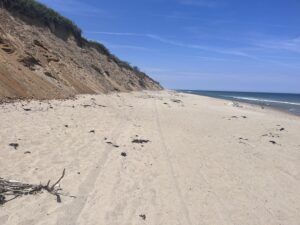This article was updated on June 20, 2024.
EASTHAM — A small tour plane made an emergency landing between Marconi Beach in Wellfleet and Nauset Light Beach in Eastham Sunday afternoon, according to the Wellfleet Police Dept. The pilot and two passengers — a man and his 12-year-old daughter — were uninjured.

Stick’n Rudder Aero Tours pilot Charles Ernst landed the plane, a single-engine Cessna 172, 15 minutes after the plane lost power. The flight originated at Chatham Municipal Airport. Wellfleet Fire Chief Rich Pauley said Ernst had determined he was unable to fly back to Chatham or make it to Provincetown before landing on the beach around 3:45 p.m. Sunday.
“The aircraft’s engine was losing power for reasons unknown at this time,” wrote Timothy Howard, the president of Cape Aerial Tours, in an email, “so a safe emergency landing site had to be selected by the pilot.”
By the time a reporter and photographer from the Independent arrived at Nauset Light Beach before 7 a.m. Monday, all that was left to see were a pair of larger-than-ranger-vehicle-size tracks in the sand.
Pauley, who spoke to the pilot and passengers at the scene, said they appeared unscathed.
“They seemed better off than I would have been,” Pauley said.
Howard told the Independent that the plane’s nose and propeller were damaged during the landing, and that the aircraft’s future was uncertain pending an assessment of its possible repair. Though the plane ended up closer to Marconi Beach in Wellfleet, first responders could not access the plane there because of the steep dunes that line the Wellfleet beaches.
The Wellfleet fire and police departments and National Park Service rangers set up a staging area south of the plane in the Nauset Light Beach parking lot. Once it was determined that the passengers and pilot were all uninjured, the process of getting the plane off the beach began: its wings were removed, and over the course of two hours, a Park ranger’s truck slowly pulled the plane approximately two miles down the beach.
Meghan Lynch, a wedding photographer from Weymouth, arrived at Nauset Light Beach just as Wellfleet first responders pulled into the parking lot. For the next two hours, Lynch watched as the emergency vehicles made a slow but steady march, airplane in tow, toward where she was watching from near the path to the parking lot. She hadn’t taken any pictures.
“Everything on the beach was still super normal,” said Lynch. “The surfers were still in the water.”
The Federal Aviation Administration and National Park Service are both investigating the incident.
Howard said that the company was cooperating with the FAA’s investigation and that it had suspended all its tours on Monday for a “safety stand down and review.”
Chatham Municipal is a public-use airport, meaning that it is shared by charter flights, tour companies, and private airplane owners. Cape Aerial Tours, which according to public records was established in September 1998, operates out of the airport. Howard — the company president — is also the airport manager.
The company offers tours around the Outer Cape. Sunday’s flight was headed to Provincetown before it lost power.
The Cessna 172 Skyhawk is the most common single-engine plane in the world, one of two planes advertised on the Stick’n Rudder Aero Tours website. The one involved in Sunday’s incident was built in 1963, according to FAA records.
Beach Landings
Emergency landing guidance from the Aircraft Owners and Pilots Association is to land on long stretches of beach with wet and firm sand when the area is not crowded. The alternative, a water landing, exposes passengers to hypothermia before rescue.
Justin Green, an aviation attorney in New York, said that returning to an airport is usually preferable to a beach landing, depending on the surf and beach conditions, including how crowded the area is.
“It sounds fortunate,” Green said of the Sunday landing. “A lot of people get in trouble trying to get to the perfect landing spot.”
Green said how compacted the sand is could affect the plane’s landing gear, tipping the plane forward or flipping it completely.
Sunday’s landing was not the first time the back shore has been used as a makeshift runway.
“The beaches for an emergency landing spot on the Cape are probably about as good as it gets,” said Dan Wolf, the former CEO of Cape Air who has been flying planes on Cape Cod for more than 46 years.
The incident didn’t seem to rattle him. “Aircraft engines are reliably maintained, overhauled at regular intervals, and they’re inspected regularly,” said Wolf. “Occasionally, something will go wrong, but it’s very rare.”
Wolf told the Independent that, when making a descent onto a beach, the first priority is flying into the wind so that the plane can slow down as much as possible. A Cessna 172 would likely be moving at only 35 to 40 m.p.h. when it touched down if wind conditions were favorable, Wolf said.
The Cessna 172 has a glide ratio of about 10 to 1, meaning that it travels about 1,000 meters horizontally for every 100-meter loss of altitude. Wolf said that pilots are trained to glide without power.
Wolf recalled that when he was manager of the Chatham Municipal Airport in the mid-1980s, a pilot in a Cessna 172 made a similar emergency landing on an oceanside Eastham beach a few miles south of Sunday’s incident. That plane, he said, sustained only limited damage to its landing gear and propeller.
According to Wolf, in the 1950s and 1960s elective beach landings on Cape Cod were commonplace. Pilots in small planes would land to go fishing on the back shore’s then-remote beaches.
There have been at least three other small plane landings on beaches so far in 2024, according to local reporting from Miramar Beach, Fla., Cedar Beach, N.Y., and Half Moon Bay, Calif. No fatalities were reported in any of them.
